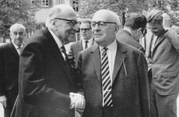
Back نظرية الفعل التواصلي Arabic Teorien om den kommunikative handlen Danish Theorie des kommunikativen Handelns German Acción comunicativa Spanish نظریه کنش ارتباطی Persian Théorie de l'agir communicationnel French A kommunikatív cselekvés elmélete Hungarian Teoria dell'agire comunicativo Italian コミュニケーション的行為の理論 Japanese 의사소통 행위 이론 Korean
 Cover of the German edition | |
| Author | Jürgen Habermas |
|---|---|
| Original title | Theorie des kommunikativen Handelns |
| Translator | Thomas McCarthy |
| Language | German |
| Subject | Communicative action |
| Published | 1981 |
| Publication place | Germany |
| Media type | |
| Pages | 465 (English edition, vol. 1) 457 (English edition, vol. 2) |
| ISBN | 0-8070-1507-5 (English edition, vol. 1) 0-8070-1401-x (English edition, vol. 2) |
| Part of a series on the |
| Frankfurt School |
|---|
 |
The Theory of Communicative Action (German: Theorie des kommunikativen Handelns) is a two-volume 1981 book by the philosopher Jürgen Habermas, in which the author continues his project of finding a way to ground "the social sciences in a theory of language",[1] which had been set out in On the Logic of the Social Sciences (1967).[1][2] The two volumes are Reason and the Rationalization of Society (Handlungsrationalität und gesellschaftliche Rationalisierung),[3] in which Habermas establishes a concept of communicative rationality,[4] and Lifeworld and System: A Critique of Functionalist Reason (Zur Kritik der funktionalistischen Vernunft),[5] in which Habermas creates the two level concept of society and lays out the critical theory for modernity.[4]
After writing The Theory of Communicative Action, Habermas expanded upon the theory of communicative action by using it as the basis of his theory of morality, democracy, and law.[6] The work has inspired many responses by social theorists and philosophers, and in 1998 was listed by the International Sociological Association as the eighth most important sociological book of the 20th century.[7]
- ^ a b Habermas 1988, p. xiv.
- ^ Habermas 1984, p. xxxix.
- ^ Habermas 1984.
- ^ a b McCarthy 1984, p. vi.
- ^ Habermas 1987.
- ^ Fultner 2011, p. 54.
- ^ "ISA - International Sociological Association: Books of the Century". International Sociological Association. 1998. Archived from the original on 2014-03-15. Retrieved 2012-07-25.